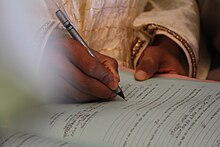Islamic marriage contract
Prior to the Advent of Islam, men were allowed to marry or divorce whenever they pleased leading to a number of problems within the society.This is supported by various Hadiths and quotations: Sahih Bukhari, Book 62, #81:[7][8] Al-Mughni (by Ibn Qudaamah), Kitab al Nikah:[9] Cited in (Al Aqad, 2014) the common problem of translation of marriage contracts is due to the varieties of word synonyms in the legal Arabic system which have no equivalence in the English system in terms of marriage contracts, such as: مهر, شبكه, صداق - Mahr, Shabkah, Sadaq- (dowry), whereas, all of these examples attributed and affected by the culture and tradition of the Arabic language.Though Muslim men are technically permitted to wed Muslim, Christian, Jewish (and according to a minority view Zoroastrian women), AKA the Ahl-al-Kitab (People of the Book), it is heavily discouraged to the point that some scholars (mainly of the Hanbali School of Fiqh) have ruled that this permission applies only in Dar-ul-Islam (a community where Islam is dominant and Islamic values are present).[citation needed] One main problem with interfaith marriage as seen in the Islamic community is the fear that one might abandon their faith or their children will not grow up in it.[11] Another issue that can arise is the conflict directly between the two married individuals if their religious traditions get in the way of the other, leading to a debate of which religion should be the more prominent one in the relationship.


marriage contractIslamic marriageShariaEnglish lawNikah Mut'ahcaliphsmosquesmarriage officiantArabicrights of womendivorceIslamic jurisprudence(fiqh)RitualShahadaRaka'ahTurbahSunnah prayerTarawihTahajjudNafl prayerclothingMut'ahand HajjPoliticalIslamic leadershipCaliphateMajlis-ash-ShuraImamateWilayat al-faqihBay'ahDhimmiFamilyMarriageMisyarHalalaMut‘ahPolygynyKafa'ahAdoptionBreastfeedingSexualAbortionBalighMasturbationCriminalBlasphemyMaisir (gambling)Zina (illicit sex)Hirabah (unlawful warfare and banditry)Fasad ("mischief")Mofsed-e-filarzRajm (stoning)Tazir (discretionary)Qisas (retaliation)Diya (compensation)EtiquetteGender segregationPurdahMahramHonorificsToiletEconomicHistorySadaqahBayt al-malBankingMurabahaTakafulInheritanceTaharahTayammumMiswakIstinjaDietaryDhabihahComparison with kashrutMilitaryGhanimahIstijarah (asylum)Prisoners of warIslamic studiespre-nuptial agreementsHadithsSahih BukhariProphetpeace and blessings of Allah be upon himInterfaith marriageZoroastrianPeople of the BookHanbaliIslamic marital jurisprudenceIslamic marital practicesIslamic sexual jurisprudenceMarriage in IslamMinangkabau marriageNikah HalalaNikah IjtimahNikah MisyarNikah mut‘ahNikah 'urfiRights and obligations of spouses in IslamWomen in IslamDivorce in IslamKetubahThe GuardianWayback Machine